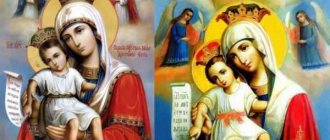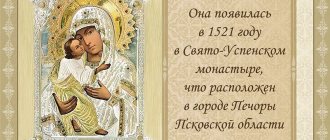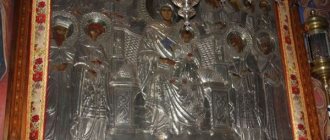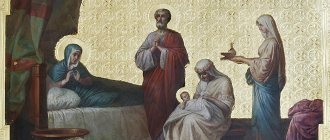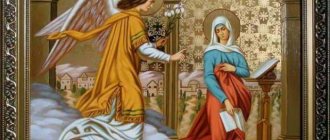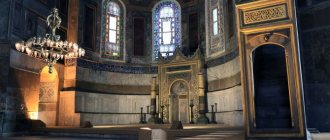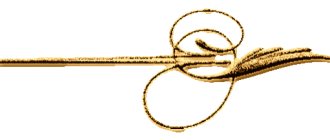Among the colossal number of sacred images of the Virgin Mary and the Infant Christ, specimens from Mount Athos acquired special veneration. The Icon of the Mother of God “It is Worthy to Eat” has an intriguing history of origin, which is carefully preserved in the annals of church traditions.
In the Orthodox tradition, this holy face, together with the famous prayer (“It is worthy to eat”), is of great importance for people asking for health and well-being. This powerful image can heal a person’s mind from all mortal sins.
Iconography
That image of “It is worthy to eat,” known to the laity today, developed in a later period.
Initially, it was completely different: it was a typical half-length image of the Mother of God with the Baby Jesus in her arms and was reminiscent of the “Tenderness” style. In subsequent lists these two divine figures are retained as the basis.
Icon of the Mother of God “It is Worthy to Eat” (“Merciful”)
The remaining elements were born and added to the image in the process of spiritual discovery and comprehension of miraculous events.
- At the same level with the heads of the Virgin Mary and the Child Jesus, on either side, two heavenly messengers are shown with outstretched arms.
- At the very top of the holy image “It is worthy to eat” sits the Most High Father, who is surrounded by the Heavenly Army of Archangels. These creatures symbolize the divinity of the chant addressed to God.
- The images of the main figures, the Virgin and Child, acquire new features that speak of their royal greatness.
- There are crowns on their heads, and their gazes are turned towards the prayer book, which is located in the hands of the newborn Christ. This scroll contains evidence that Jesus is the true ruler of spirituality.
Other varieties of the sacred image “It is worthy to eat” are also known in church iconographies. The plot shows hosts of angels and saints reading a prayer service before the Most Pure Mother. This type of image was widely used in ancient Russian art of the 17th century.
Read about prayers to the Heavenly Powers:
- Akathist to Archangel Michael
- Akathist to Archangel Gabriel
- Akathist to the Holy Guardian Angel
In style, this shrine is close to the fresco images called “Rejoices in You,” which were usually placed on church altars.
- The Mother of God is presented in full growth, she is holding the All-Good Child in her arms.
- The figure of the Blessed Virgin is surrounded by a double (sometimes triple) mandala (a geometric figure of complex design), symbolizing the Heavenly abode.
- The Supreme Father is depicted in the clouds above the figures of Mother and Christ.
- On the sides appear angels and holy saints in hierarchy order.
- Around the image of the Most Pure One the text of the prayer petition “It is worthy to eat” is written.
Interesting!
The shrine was often written on specific vessels called panagiars. They contain a prosphora consecrated by the Mother of God. Panagiars are brought out during the offering of the rite of Panagia (a small image of the Virgin Mary, Christ or the Trinity). Today in Russian churches the believer will find many lists of the famous “Merciful” shrine. It can be found in the Galernaya harbor of St. Petersburg or in the capital's Trinity-Sergius Lavra. The lists were brought here directly from the Holy Mountain. Russian clergy and parishioners are firmly convinced that the Most Pure Virgin provides divine mercy for our people.
Icon of the Most Holy Theotokos “It is Worthy to Eat” (“Merciful”)
Icon of the Mother of God “It is Worthy to Eat” (“Merciful”)
The miraculous icon of the Mother of God “It is Worthy to Eat” is deeply revered by believers. People turn to her for help in a variety of situations. Every year many pilgrims flock to the holy image.
Icons depicting the Mother of God are highly valued in the Orthodox world. Among them there are those that are revered as miraculous and acquired by Christians as a strong amulet that does not allow negativity to enter the home and hearts of people. One of these icons is considered to be the image of the Mother of God “It is Worthy to Eat.”
History of the icon
At the end of the tenth century, the Archangel Gabriel revealed himself to a novice of an old hermit. He knocked on the cell door, and the surprised young man let the stranger in. The old man who entered was unremarkable. However, when the time came to offer a prayer in front of the “Merciful” icon, the guest stopped the young man and said different words of prayer. The novice was surprised and asked the elder to write down the words. He, not finding paper or ink in the cell, inscribed words on the stone, which became pliable, like wax. He then disappeared, telling the surprised novice his name. The news of the miraculous appearance of the archangel reached Constantinople, and the novice, as proof of his words, provided a stone slab with a prayer inscribed on it, beginning with the words “It is worthy to eat.” Since then, the icon has acquired a second name and now exists with two names.
Where is the “It is Worthy to Eat” icon located?
The miraculous icon of the Mother of God is located in the capital of Athos, in the city of Kareya, on the altar of the cathedral church. The time of her appearance is determined in 980, glorification - in 1864.
A copy of the Athos icon is located in the church built in honor of the Mother of God in the city of St. Petersburg. There is another copy in Moscow, in the Holy Trinity Sergius Lavra.
Another copy of the icon, delivered from Athos, is located in Orenburg. There you can venerate the image in the women's monastery.
Description of the icon
The “It is Worthy to Eat” icon changed its appearance over time. Initially, it depicted the face of the Virgin Mary, who was holding the baby Jesus in her right hand. Over time, her image began to be painted differently. Now this icon depicts the Mother of God, to whom the Son of God clings. The baby holds a prayer in his hands. While changing, the icon has not lost its significance and continues to help anyone who asks in their troubles and humble requests.
How does the icon of the Mother of God help?
All Orthodox Christians turn to the help of the Most Holy Theotokos. The icon helps with the following:
- gives healing from diseases and ailments, both physical and spiritual;
- helps at the beginning and end of any business. She is asked for blessings before difficult tasks and thanks upon completion;
- they pray to the icon during epidemics and accidents;
- The Mother of God helps restore peace in the family, protects loving hearts from envious people, and also helps lonely hearts find true love;
- Before the image they offer prayers for the remission of any sins.
The miracles that the icon works are numerous. For example, a fire raging on Mount Athos, destroying monasteries, died out when an icon was brought to the site of the tragedy and prayers were offered to the Mother of God.
Prayer before the icon
“Most Holy Merciful Mother of God! We humbly pray to You, falling before the holy face. Do not reject our requests and be imbued with our troubles and sorrows. Help, Mother of God, the helpless servants of God, pray to the Lord for us, show your philanthropy and boundless mercy. Ask our Lord for health for us and our families and put out the fire in bodies consumed by illnesses. We humbly pray to You for deliverance from misfortunes and glorify Your name throughout the ages. Heal, Mother, the sick and suffering, and comfort the mourners, and provide your autumn cover for all those deprived of goodness in a sinful life. Amen".
Icon Veneration Day
Orthodox Christians celebrate the day of the Mother of God “Merciful” or “It is Worthy to Eat” on June 24 according to the new style, June 11 according to the old style.
Any Orthodox Christian can ask the Mother of God for protection, opening his heart to meet the Lord. The icon acquires special power on the day of veneration, when thousands of believers offer a single prayer. They say that on this day the Heavens open and listen to every word spoken. We wish you happiness, and do not forget to press the buttons and
We advise you to study the most common questions Muslims have about Christianity
What can you pray to the image for?
The Holy Mountain of Athos is a great place where the darkness and sorrow of a sinful life are illuminated. Here, according to the wisest holy fathers, there is an invisible connection between worldly life and the Heavenly abode. On this land, which is under the special protection of the Most Pure Virgin, the Icon of the Mother of God “It is Worthy to Eat” resides. A believer will never remain alone on the path of life; he is accompanied by: the Guardian Angel, the Virgin Mary and the Lord. A prayer request for help takes place in front of miraculous icons.
Note! “It is worthy to eat” is a widely used Orthodox prayer in the worship procedure. The authorship is attributed to a church poet named Cosma Mayumsky, who lived in the 8th century. The prayer is always accompanied by a special refrain, “The most honorable cherub.”
The “merciful” shrine of the Blessed Virgin helps in the following:
- Allows you to successfully complete your planned endeavor.
- A prayer service in front of the holy face helps to restore lost health.
- The Blessed Virgin has the power to restore optimal relationships within the family.
- A person who reads the prayer words in front of the shrine “It is worthy to eat” can receive forgiveness for the most serious sin.
- The power of the Mother of God has the power to help in the most hopeless problems, as she is known for her divine patience and forgiving attitude even towards criminals.
- The Queen of Heaven eliminates envy by teaching you to rejoice in the achievements of others.
- If a believer notices in himself great inclinations towards fornication or gluttony, it is necessary to sincerely and humbly ask the Most Pure Mother for deliverance from these obsessions that hinder the liberation of the soul.
- Prayers before the holy face of the “Merciful One” get rid of the demon of anger, which rests in the heart and manifests itself at the most inopportune moment.
- If a Christian is trying to eradicate disgusting greed in himself, a prayer to the Virgin Mary will free a person from thoughts that material goods have any value.
It is extremely important for a believer to admit his own guilt and drown out the pride that does not allow him to adequately approach the decision. It heals the soul and body from laziness, which repels a person from visiting temples.
Interesting! After the Council of Trullo in 691 in the Byzantine capital, Athos, the birthplace of the icon of the “Merciful” Mother of God, became an exclusively monastic place. Many Christians who experienced persecution from the Mohammedans flocked to this Sacred Mountain.
Shrines of Athos: The miraculous icon of the Mother of God “It is worthy to eat” (“Merciful”)
On June 24, the Orthodox Church celebrates in honor of the icon of the Mother of God “It Is Worthy” (“Merciful”) (Greek: “Axion Estin”), kept in Kareia, the capital of Holy Mount Athos, in the main church of Protata.
The history of this image is connected with a miraculous event that happened in the 10th century.
Not far from the capital of Athos, Kareya, there lived an old man with his novice. The monks rarely left their secluded cell, named in honor of the Dormition of the Blessed Virgin Mary, and only when absolutely necessary. It happened that the elder went one day to the Sunday all-night vigil at the Protat Church of the Dormition of the Blessed Virgin Mary; His disciple remained to guard the cell, having received orders from the elder to perform the service at home. When night fell, he heard a knock on the door and, opening it, saw an unfamiliar monk, whom he received respectfully and cordially. When the time came for the all-night service, they both began chanting prayers.
When it was the turn of the hymn of the Mother of God, both stood before Her icon and began to sing: “Most honorable Cherub. " At the end of the prayer, the guest said: “We don’t call the Mother of God that way. We sing first: “It is worthy to truly bless Thee, the Mother of God, the Ever-Blessed and Most Immaculate, and the Mother of our God” - and after this song we add: “The most honorable cherub.” "".
The young monk was moved to tears, listening to the singing of a chant he had never heard, and began to ask the guest to write it, so that he could learn to glorify the Mother of God in the same way. But there was no ink or paper in the cell. Then the guest said: “So I will write this song for your memory on this stone, and you memorize it, sing it yourself, and teach all Christians to glorify the Most Holy Theotokos in this way.” The stone, like wax, softened under the hand of the wondrous guest. Having inscribed this song on it, he handed it to the novice and, calling himself Gabriel, instantly became invisible.
The novice spent the whole night in praise before the icon of the Mother of God. The elder, returning from Kareya, found him singing a new wonderful song. The novice showed him a stone slab and told him everything that happened. The elder announced this to the council of the Holy Mountain residents, and everyone, with one mouth and one heart, glorified the Lord and the Mother of God and sang a new song.
Since then, Orthodox Christians have sung the prayer “It is worthy to eat” every day. "at church services, and the icon in front of which the Archangel prayed was transferred to the Protat Cathedral and began to be venerated as a great shrine.
The slab with the song inscribed by the Archangel was delivered to Constantinople during the reign of Basil and Constantine the Porphyrogenitus, during the patriarchate of St. Nicholas Chrysoverkh (983-996). The cell where the miracle happened is still known on Mount Athos under the name “It is Worthy to Eat,” and that area began to be called “Adin” (from the Greek word “to sing”) in memory of the appearance of the Archangel Gabriel.
Every year on the second day of Easter, a multi-hour procession with the miraculous image “It is Worthy to Eat” is held on the Holy Mountain. Representatives of all Svyatogorsk monasteries and the secular authorities of Athos participate in the procession.
How to pray in front of an icon
The Most Pure Virgin is distinguished by infinite mercy, understands every parishioner and is capable of changing fate. A large number of people flock to her: they ask for healing of their bodies and hearts. The Chronicles describe many miraculous events that took place according to the will of the Mother of God.
“Merciful” shrine of the Blessed Virgin
The petition for each believer is unique; one is allowed to approach the shrine as it turns out. You can kiss your face. The clergy claim that she understands all languages.
- The best thing to do is to read texts compiled by authoritative clergy or sent by heavenly angels. Such petitions are well structured, and every word carries a correct and deep thought.
- When turning to the Most Pure Virgin, one should renounce past grievances and concentrate on the purpose of the parish.
- You should ask her for forgiveness for sinful life and recognize that the Mother of God has the power to heal illnesses and deliver from sinfulness.
- The thoughts of the person asking are directed towards the salvation of his soul and all others. You need to beg for salvation from torment in eternal fire.
- Only after such global prayers is it recommended to move on to everyday problems.
- You cannot complain about circumstances and other people, demand punishment, or try to force someone to act according to your own wishes. This will be regarded as witchcraft practice, and not Orthodox sincere prayer.
Important!
“It is worthy to eat” is used independently, at any moment when you have free time. If a believer recites the rosary, it is necessary to take a blessing from the clergy. The latter encourage the aspiration that has arisen, but warn that various demons immediately begin to erect temptations before the mind of the neophyte. You must not give up; you should practice daily prayer in front of the images of Christ, the Virgin Mary and the saints.
Where is the Tabyn Icon of the Mother of God located?
There are legends about the current location of the miraculous face of the Mother of God, and no one can reliably say where the original is now. During the civil war, the list was taken to China by the Cossack chieftain Dutov. Legends say that even the Chinese worshiped Her image, which brought success.
And after 1948, the list was taken from China to Australia, soon the shrine ended up in the USA, and no one knows more about where the miraculous shrine is located. Today, you can make a pilgrimage to numerous lists written from the legendary image in many churches in Russia:
- In the Chelyabinsk region in the village of Smirnovsk;
- In the Church of the Ascension in the village of Tabynsk;
- In Krasnoulsk in the Church of the Holy Keys;
- In Orenburg, in a church-chapel named after this image of the Most Pure One.
Every year there are religious processions led by a miraculous image. And the celebration of the day of the Tabynskaya icon is always celebrated on the 9th Friday after Easter - on the Day of the Appearance of the Shrine. On the day of veneration at the Holy Springs, more than 20 thousand believers gather at the site of the appearance of the face of the Mother of God.
God bless you!
Watch a video about the history of the appearance of the Tabynskaya Mother of God icon:
Icons
The history of the prayer “It is worthy to eat”
Prayer is communication with God. We know some prayers, such as the Lord's Prayer, from Scripture. Church hymnographers write prayers that we can read in the Menaion; people pray privately in prayers that they write themselves. Some, such as the prayer “It is worthy to eat,” have an unusual history and meaning. Prayer is not always a request addressed to God or thanksgiving. We glorify the Lord, the Mother of God and the saints, addressing them in a special way during the service.
As a rule, the prayer rule ends with the prayer “It is worthy to eat.” This is a prayer to the Mother of God. The prayer “It is worthy to eat” does not apply to either petitionary or thanksgiving prayers. Such prayers are called doxological prayers. In this prayer we glorify the Mother of God as the Mother of God, we worthily praise the One who immaculately conceived Christ. This means that we recognize the Virgin Mary as the Mother of our God. And Jesus is the Savior and Messiah.
The prayer “It is worthy to eat” was created at a time when there were heresies that the Virgin Mary should be correctly called not the Mother of God, but the Mother of Christ. The reason for this was the heresy of Paul of Samosata, who argued that Christ was not born God, but became Him, which means that the Virgin Mary is the Mother of Christ, and not the Mother of God. There were serious discussions on this topic, but the Church resolutely rejected this heretical statement, since it diminished the glory of the Mother of God. The prayer “It is worthy to eat” recognizes the Virgin Mary as super-immaculate, immaculate in the highest degree “Most Immaculate,” the Mother of God.
We advise you to study the Prayers before the Feodorovskaya Icon of the Mother of God
After the Third Ecumenical Council (Ephesus, which took place in 431), the false teaching of the Patriarch of Constantinople Nestorius was refuted, who also stated that Christ was born human and acquired the Divine nature only at the time of Baptism. Nestorius denied the Mother of God and called the Virgin Mary the mother of the man Jesus, the Mother of Christ. The fathers of the Council of Ephesus did not agree with him and solemnly proclaimed the Virgin Mary the Mother of God. The memory of these events became the reason why there was a need to write a special doxological prayer.
The prayer says that the Mother of God is above the highest ranks of angels. In Her glory, the Virgin Mary surpassed the angels. The words “without decay” in the prayer “It is worthy to eat” indicate that without damaging or violating the purity of God the Son (God the Word), the Virgin Mary gave birth to Him into our world. God is Triune and God the Word is one of His hypostases. “The Real Mother of God” - these words mean “the real Mother of God.”
In prayer we express our trust in the Mother of God and glorify Her. The prayer “It is worthy to eat” consists of two parts. The second part, beginning with “The most honorable cherub,” appeared later than the first, which begins with the words “It is worthy to eat.” In the 8th century, the second part of the prayer was written by the Monk Cosmas, Bishop of Maium. The Monk Cosmas wrote many more church hymns and chants, prayers, which can be found in the Menaion.
The first part of the prayer “It is worthy to eat” arose in the 10th century on the holy Mount Athos; it has a very unusual history: according to one legend, it is believed that a certain monk saw an angel of the Lord, who appeared to him in the form of a monk. When they prayed together and read the prayer “The Most Honest Cherub” and proclaimed the beginning of the prayer. When the Athonite monk sadly said that he had nowhere to write down the text of the prayer “It is worthy to eat,” the angel simply inscribed it with his finger on a stone and disappeared into thin air.
History of veneration
The Byzantine church poet and hymnographer Cosmas Mayumsky composed the text of the glorification of the Most Holy Theotokos, “The Most Honorable Cherub.” This hymn was sung in the churches of Byzantium, Holy Rus', and Iberia. But in 980 an event occurred that forced some changes to the text of the anthem. And it was like that. Not far from Kareya, an old hermit monk and his young novice labored in a cell. The elder used to go to church to pray on the eve of Sunday. He ordered the ascetic to stay in his cell and create his rule.
Quite a bit of time passed and there was a knock on the door of the cell. The young monk opened the door and saw a monk whom he had never met in these places before. He asked to enter, and within a few minutes both were praying in front of the image of the Mother of God “Mercy.”
At the end of the rule, the elder’s novice began to praise the “Most Honorable Cherub.” The mysterious guest, stopping him, said: “This is not how you call the Most Pure One. We do it differently." The monk realized where this “with us” was later. In the meantime, the guest sang: “It is worthy to eat as truly...” and only at the end he added “The Most Honest Cherub.” “So pray,” he finished. The novice cried from the feelings that overwhelmed his heart, and an unearthly radiance continued to emanate from the icon.
Fearing to forget the words he heard, the young monk asked the guest to write them down. But what, other than to write on a stone? At the touch of the palms of the mysterious visitor, the stone softened and on it, as if on clay, he wrote the text of the prayer. And then he immediately got ready to hit the road. Seeing off the guest, the monk inquired about his name. He answered: “Gabriel” and became invisible.
The novice told the returning elder in detail everything that had happened to him. He was moved by emotion when he heard the divinely inspired words of the prayer. And when his young companion showed the stone with the inscription, he concluded: “The wonderful guest who visited us is the Archangel Gabriel. And this prayer is another one of those announced to people by angels.”
The news of what happened quickly spread throughout Athos. The prayer sung by the archangel was included in the Orthodox service. Since then and to this day, this chant has been heard at all services, with a few exceptions. The Athonite monks sent the stone with the written text to Constantinople to confirm the truth of their story. The icon, in front of which the Archangel Gabriel, through the Athonite novice, taught all Christians to magnify the Mother of God, began to be called “It is Worthy to Eat,” but the old name “Merciful” remained with it.
Over the course of a thousand years, the icon left its place four times. For the first time in 1963, during the celebration of the millennium of the Holy Mountain, she was met in Athens. In 1985, the icon was brought to Thessaloniki on the occasion of the celebration of the 2300th anniversary of the city. In 1987, the icon was again exhibited for public worship in the ancient Hellenic capital. For eighteen days the human flow to her did not deplete. In 1994, the icon spent several days on the island of Crete.
Icon of the Mother of God of Tenderness of Lokot
From April 1 to April 8, the Lokot Icon of the Mother of God “Tenderness” will be in the Smolensk Church.
From February to June, in the churches of the Oryol Metropolis, with the blessing of His Eminence Metropolitan Anthony of Oryol and Bolkhov, there will be a miraculous icon of the Mother of God “Tenderness” from the village of Lokot. In 1999, the icon began to stream myrrh. This is a two-sided miraculous myrrh-streaming image.
The history of the appearance of the icon.
The shrine appeared in one pious family in the village of Lokot, the former estate of Grand Duke Mikhail Romanov, brother of Tsar Nicholas II.
A resident of the village of Lokot, Bryansk region, Natalya Shishkova, as usual, went to the local department store and saw calendars with the image of the Mother of God lying neglected on the store counter.
She made a remark to the saleswoman that even though the calendars are not church calendars, since there is an image of the face of the Mother of God, it is unworthy to store it in this form, but it is necessary to store it in a proper way.
To which the saleswoman said that these calendars were expired, and anyway no one would buy them and they would have to be thrown away.
Natalya went home, and on the way the thought occurred to her that she had denounced the saleswoman, but she herself just needed to buy this calendar. She went back and bought the last two calendars of the Mother of God with the Tenderness icon. I cut off the numbers and hung them on the wall at home and at work using regular push pins.
As in the case of the Iveron Montreal Icon of the Blessed Virgin Mary, she at first decided that someone had spilled cologne or perfume in the house, but when she began to look for the source of the aroma, she discovered that a large, greasy, fragrant stain had formed on the face of the Mother of God.
She invited a priest, who, having looked, noticed that now this often happens, when not only in churches, but also in the homes of lay people, images begin to stream myrrh, that you don’t need to pay attention to it, you look - it streams myrrh and will pass.
But the flow of myrrh and the fragrance did not stop; moreover, the flow of myrrh increased over time in such quantity that the myrrh flowed from the image onto the wall.
Seeing this, the priest said that this must be approached with caution, in case this miracle is not from God: “Let’s pray, and if during Great Lent this miracle stops, then this miracle is not God’s.” But on Easter, in their house, all the icons that they have, and there are quite a lot of them, were filled with myrrh. It became clear that this was truly a miracle and they decided to place this image in an icon case, in a frame
It became clear that this was truly a miracle and they decided to place this image in an icon case.
They took it off the wall and, to their amazement, discovered this: you know that myrrh is an oily substance that saturates the paper right through, and since the entire image was covered with myrrh, it would seem that the calendar should also soak up this world through and through.
But when they took it off the wall, they saw that on the reverse side only the face of the Mother of God was saturated with the world! The rest of the surface of the calendar remained as white and dry as before.
The study of miracles associated with the icon of “Tenderness” is carried out by a special expert group on miraculous phenomena in the Russian Orthodox Church under the leadership of Professor P.V. Florensky. Over the past 19 years, there have been many cases of healing and grace-filled help in everyday needs of people who came to her to worship.
Schedule of stay of the Lokot Icon of the Mother of God
- April 1 - April 8 - Smolensk Church;
- April 8 - April 15 - Epiphany Church;
- April 15 - April 19 - Baptist Church;
- April 19 - April 24 - Alexander Nevsky Church (900 block);
- April 24 - April 29 - St. Nicholas Church;
- April 29 - May 3 - Vvedensky Convent;
- May 3 - May 8 - Trinity Church;
- May 8 - May 13 - Mtsensk;
- May 13 - May 20 - Bolkhov.
Materials from the Information and Analytical Department of the Oryol Metropolis were used
